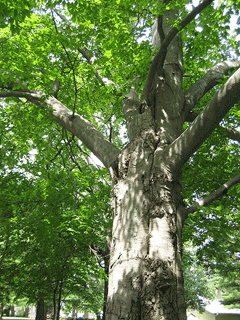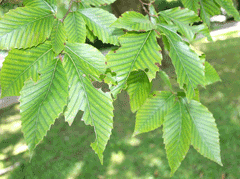 |
|
http://commons.wikimedia.org/wiki/User:IvoShandor |
 |
| http://commons.wikimedia.org/wiki/User:Jean-Pol_GRANDMONT |
Translate this page:
Summary
Bloom Color: Unknown. Main Bloom Time: Early spring, Late spring, Mid spring. Form: Oval, Pyramidal.
Physical Characteristics

 Fagus grandifolia is a deciduous Tree growing to 10 m (32ft) by 10 m (32ft) at a slow rate.
Fagus grandifolia is a deciduous Tree growing to 10 m (32ft) by 10 m (32ft) at a slow rate.
See above for USDA hardiness. It is hardy to UK zone 4 and is not frost tender. It is in flower from April to May, and the seeds ripen from October to November. The species is monoecious (individual flowers are either male or female, but both sexes can be found on the same plant) and is pollinated by Wind.
Suitable for: light (sandy) and medium (loamy) soils and prefers well-drained soil. Suitable pH: mildly acid, neutral and basic (mildly alkaline) soils. It can grow in full shade (deep woodland) semi-shade (light woodland) or no shade. It prefers dry or moist soil.
UK Hardiness Map
US Hardiness Map
Synonyms
Plant Habitats
Woodland Garden Canopy; Secondary;
Edible Uses
Edible Parts: Inner bark Leaves Oil Oil Seed
Edible Uses: Coffee Oil Oil
Young leaves - raw or cooked as a potherb[183]. A very nice mild flavour but the leaves quickly become tough so only the youngest should be used. New growth is usually produced for 2 periods of 3 weeks each year, one in spring and one in mid-summer. Seed - raw or cooked. Small but very sweet and nutritious[82, 117, 171, 183, 227], it is sold in local markets in Canada and some parts of America[82]. Rich in oil, the seed also contains up to 22% protein[213]. The raw seed should not be eaten in large quantities since it is believed to cause enteritis[159, 226]. It can be dried and ground into a powder, then used with cereal flours in making bread, cakes etc[183]. The germinating seeds can be eaten raw, they are tender, crisp, sweet and nutty[183]. The roasted seed is a coffee substitute[183, 213]. An edible semi-drying oil is obtained from the seed[177, 183]. Inner bark[177]. Dried, ground into a powder and then used as a thickening in soups etc or mixed with cereals when making bread[213].
References More on Edible Uses
Medicinal Uses
Plants For A Future can not take any responsibility for any adverse effects from the use of plants. Always seek advice from a professional before using a plant medicinally.
Pectoral Skin Vermifuge
A decoction of the boiled leaves has been used as a wash and poultice to treat frostbite, burns, poison ivy rash etc[213, 222, 257]. The nuts have been eaten as a vermifuge[222, 257]. A tea made from the bark has been used in the treatment of lung ailments[222, 257]. It has also been used to procure an abortion when the mother was suffering[257].
References More on Medicinal Uses
The Bookshop: Edible Plant Books
Our Latest books on Perennial Plants For Food Forests and Permaculture Gardens in paperback or digital formats.

Edible Tropical Plants
Food Forest Plants for Hotter Conditions: 250+ Plants For Tropical Food Forests & Permaculture Gardens.
More

Edible Temperate Plants
Plants for Your Food Forest: 500 Plants for Temperate Food Forests & Permaculture Gardens.
More

More Books
PFAF have eight books available in paperback and digital formats. Browse the shop for more information.
Shop Now
Other Uses
Charcoal Oil Oil Wood
The oil obtained from the seed has been used as a fuel in oil lamps[226]. Wood - strong, hard, heavy, very close grained, not durable, difficult to cure[61, 82, 227]. It weighs 43lb per cubic foot[227]. Harvested commercially, it is used for furniture, flooring, tool handles, crates etc[227]. It makes an excellent charcoal and is used in artwork[61, 227]. A dynamic accumulator gathering minerals or nutrients from the soil and storing them in a more bioavailable form - used as fertilizer or to improve mulch.
Special Uses
Dynamic accumulator Food Forest
References More on Other Uses
Cultivation details
Landscape Uses:Firewood, Pest tolerant, Hedge, Aggressive surface roots possible, Screen, Specimen, Woodland garden. Thrives on a light or medium soil[11], doing well on chalk[1], but ill-adapted for heavy wet soils[1]. Young trees are very shade tolerant, but are subject to frost damage so are best grown in a woodland position which will protect them[200]. Although very cold hardy, this species requires hotter summers than are normally experienced in Britain so is not usually a success here and is very slow growing[200]. The seeds are dispersed after the first frosts[227], they are sometimes gathered and sold in local markets in N. America[82, 227]. Good crops are produced every 2 - 3 years in the wild[227]. This species produces suckers[11] and often forms thickets in the wild[227]. Trees have surface-feeding roots and also cast a dense shade, this greatly inhibits the growth of other plants and, especially where a number of the trees are growing together, the ground beneath them is often almost devoid of vegetation[226, 227]. Special Features:
North American native, All or parts of this plant are poisonous, Inconspicuous flowers or blooms. The plant is heat tolerant in zones 9 through 1. (Plant Hardiness Zones show how well plants withstand cold winter temperatures.
Plant Heat Zones show when plants would start suffering from the heat.
The Plant Heat Zone map is based on the number of "heat days" experienced in a given area where the temperature climbs to over 86 degrees F (30°C).
At this temperature, many plants begin to suffer physiological damage. Heat Zones range from 1 (no heat days) to 12 (210 or more heat days).
For example Heat Zone. 11-1 indicates that the plant is heat tolerant in zones 11 through 1.) For polyculture design as well as the above-ground architecture (form - tree, shrub etc. and size shown above) information on the habit and root pattern is also useful and given here if available. A sprouting standard sending up shoots from the base [1-2]. The root pattern is flat with shallow roots forming a plate near the soil surface [1-2]. The root pattern is a heart root, dividing from the crown into several primary roots going down and out [1-2]. The root pattern is suckering with new plants from underground runners away from the plant [1-2].
References Carbon Farming Information and Carbon Sequestration Information
Temperature Converter
Type a value in the Celsius field to convert the value to Fahrenheit:
Fahrenheit:
The PFAF Bookshop
Plants For A Future have a number of books available in paperback and digital form. Book titles include Edible Plants, Edible Perennials, Edible Trees,Edible Shrubs, Woodland Gardening, and Temperate Food Forest Plants. Our new book is Food Forest Plants For Hotter Conditions (Tropical and Sub-Tropical).
Shop Now
Plant Propagation
Seed - the seed has a short viability and is best sown as soon as it is ripe in the autumn in a cold frame. Protect the seed from mice. Germination takes place in the spring. When they are large enough to handle, prick the seedlings out into individual pots and grow them on in the greenhouse for at least their first winter. Plant them out into their permanent positions in late spring or early summer, after the last expected frosts. The seedlings are slow growing for the first few years and are very susceptible to damage by late frosts. The seed can also be sown in an outdoor seedbed in the autumn. The seedlings can be left in the open ground for three years before transplanting, but do best if put into their final positions as soon as possible and given some protection from spring frosts.
Other Names
If available other names are mentioned here
Native Range
NORTHERN AMERICA: Alabama, Arkansas, Connecticut, Delaware, District of Columbia, Florida, Georgia, Illinois, Indiana, Kentucky, Louisiana, Maine, Maryland, Massachusetts, Mexico Central, Mexico Gulf, Mexico Northeast, Michigan, Mississippi, Missouri, New Brunswick, New Hampshire, New Jersey, New York, North Carolina, Nova Scotia, Ohio, Oklahoma, Ontario, Pennsylvania, Prince Edward I., Québec, Rhode I., South Carolina, Tennessee, Texas, Vermont, Virginia, West Virginia, Wisconsin,
Weed Potential
Right plant wrong place. We are currently updating this section.
Please note that a plant may be invasive in one area but may not in your area so it's worth checking.
Conservation Status
IUCN Red List of Threatened Plants Status :

Growth: S = slow M = medium F = fast. Soil: L = light (sandy) M = medium H = heavy (clay). pH: A = acid N = neutral B = basic (alkaline). Shade: F = full shade S = semi-shade N = no shade. Moisture: D = dry M = Moist We = wet Wa = water.
Now available:
Food Forest Plants for Mediterranean Conditions
350+ Perennial Plants For Mediterranean and Drier Food Forests and Permaculture Gardens.
[Paperback and eBook]
This is the third in Plants For A Future's series of plant guides for food forests tailored to
specific climate zones. Following volumes on temperate and tropical ecosystems, this book focuses
on species suited to Mediterranean conditions—regions with hot, dry summers and cool, wet winters,
often facing the added challenge of climate change.
Read More
Expert comment
Author
Ehrh.
Botanical References
1143200
Links / References
For a list of references used on this page please go here
Readers comment
© 2010, Plants For A Future. Plants For A Future is a charitable company limited by guarantee, registered in England and Wales. Charity No. 1057719, Company No. 3204567.